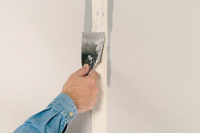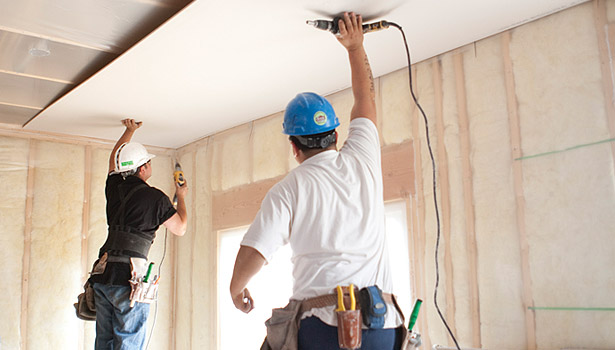Changes in Gypsum Sheathing Fastening Patterns




Dwellings are subject to both lateral and vertical loads. Lateral loads include wind and seismic forces. Examples of vertical loads include the weight of the structure itself, the furnishings, and snow on the roof. To address relevant life-safety issues, dwellings are laterally braced to prevent collapse and failure caused by a wind or seismic event. Chapter 6 of the International Residential Code describes a variety of acceptable methods that may be used to brace a dwelling.
Gypsum board has historically been used as a bracing element, either alone or in conjunction with other materials. While its use as a bracing element reflects the widespread application of gypsum board as a finish material, it also points out the strength of gypsum board as a structural element; an attribute that is often understated or overlooked.
Unfortunately, figuring out how to brace a dwelling is neither simple nor straightforward. Despite a considerable effort to make the bracing language clearer, Chapter 6 still contains some of the most daunting text in the IRC. Figuring out structural building standards that address bracing is also not a simple task.
So a bit of advice: leave the design and interpretation of bracing requirements to structural professionals. But be aware that as the language in Chapter 6 has been cleaned up, it has created changes to the language addressing the installation of exterior gypsum sheathing to wood framing members in non-braced construction. Overlooking the changes could cause you some anguish.
FASTENER PATTERNS
Editions of the IRC dated 2006 and earlier required gypsum sheathing used as bracing on wood framing to be installed using a 7/7 fastener pattern: fasteners were to be installed at 7 inches on center along all board edges, including at top and bottom plates, and in the field of the board at all intermediate framing members. Gypsum sheathing installed in a non-braced application to wood framing members was installed using a 4/8 pattern, with edge fasteners at 4 inches on center and field fasteners at 8 inches on center.
The 2009 IRC was modified to require that all gypsum sheathing that is fastened to wood studs, regardless of whether it is used as a bracing element or not, must be installed using a 7/7 fastener pattern. The change is rather hard to find in the IRC and appears only in Table R602.3(1). It is also in the 2012 edition of the IRC.
The rationale for the change, which was not pushed by the gypsum industry, was that gypsum sheathing in braced applications was being installed using the non-braced spacing pattern and that making the fastener spacing pattern and the distance between fasteners for all applications of gypsum sheathing to wood studs universal would alleviate the problem. This logic prevailed in the code hearing process despite the argument that other sheathing materials with dual fastening pattern systems were also facing a similar challenge; a situation that was not being addressed by a proposed code change.
A table helps to illustrate the impact of the change in the code language. Assume that you are installing a 4-foot by 9-foot sheet of gypsum sheathing with the bound edge parallel to the wood studs (i.e. a vertical installation). Note that 9 feet converts to 108 inches and, in this instance, the edge we are referring to is the bound, long edge of the board that is installed over a stud; not the cut end on the floor or top plate.
The table assumes that the fastener that aligns with a stud at the floor and top plate are counted as a part of the calculation. It also “rounds up” to add the extra fastener to the calculation when the spacing pattern doesn’t evenly divide into the length of the board. Note that the specific language is identical in the 2009 and 2012 IRC.
When you compare the values for the 2006 non-braced applications in the center and far right columns of the table against the corresponding values for the 2009 or 2012 non-braced application in the same columns two conclusions surface: 1) under the 2009/2012 IRC, you now need fewer edge fasteners in a non-braced application than you did under the 2006 IRC, however 2) the 2009/2012 code requires an additional fastener in a non-braced application at the intermediate studs.
At the risk of overstatement, it doesn’t sound like much of a change; however, if you don’t pick up on it, you run the risk of leaving out a single fastener on every intermediate stud when applying gypsum sheathing in a non-braced application. If you get on the wrong side of an adept inspector who is looking to red flag even the simplest of mistakes you could wind up with a messy and costly correction.
Another important point to note is that parallel language in a primary standard that addresses the application of exterior gypsum sheathing, ASTM C1280, Standard Specification for Application of Gypsum Sheathing, , is changing to resemble the code text. Previous editions of the C1280 standard required an 8/8 spacing for fasteners in a non-braced application when sheathing was attached to a wood or steel framing member. The C1280 standard now has a universal non-braced 7/7 spacing for any type of framing member. It all points out the need to carefully assess the circumstance under which you are applying gypsum sheathing. Prior to application, and particularly in a single-family dwelling or townhouse application, make sure you know the standard you are working to and the fastener pattern you are required to comply with. In addition to the bracing language, you may also have to consider the impact of a fire test report and any additional structural capacity that the sheathing is assuming. If the installation patterns conflict, ask some questions. While the on-going changes are subtle, they can become significant if ignored.
Looking for a reprint of this article?
From high-res PDFs to custom plaques, order your copy today!








